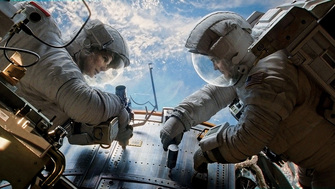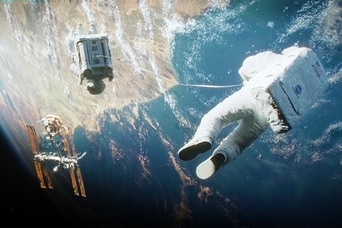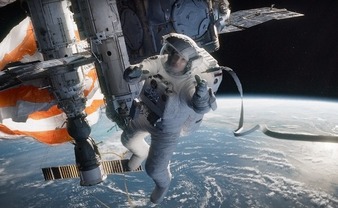
I went to see it last week and wow! – it’s a 5 star (out of five) for me. And I don’t think that’s just because I’m a self-confessed space geek! It stars George Clooney and Sandra Bullock as astronauts on a routine space
mission, during which things go dramatically wrong. It is a bit of a thriller that will appeal to most people – a story of survival in the face of overwhelming odds. And it’s fair to say a masterpiece of cinematic technology, which captures the spectacle of being in orbit – particularly if you see it in 3D. I’ve always been a fan of Sandra, and she plays a brilliant part in this. George is good as a worldly-wise, veteran astronaut, but I have to admit I kept thinking ‘Buzz Lightyear’ every time he was on screen. The depiction of local physics (weightlessness, conservation of momentum, etc) is really well done. It was one of those films when the word ‘wow’passes your lips unconsciously, due to the pure spectacle of some of the scenes! I will probably go to experience it again in IMAX 3D, but that’s just because I AM a space geek!

first components of the International Space Station (ISS) were launched (see reference at end). The paper dealt with the short-term risk to the ISS arising from the breakup of a spacecraft – just the scenario depicted in ‘Gravity’. It was amazing (and scary) to see the consequences of such an event played out so graphically in glorious 3D.
However, if you haven’t seen the movie yet, then you should stop reading here, and come back later (if you want to) after you’ve seen it.
The action starts when Matt Kowalsky (Clooney) and rookie astronaut Ryan Stone (Bullock) are performing a routine Space Shuttle maintenance mission on the Hubble Space Telescope, when a report of a spacecraft fragmentation comes over the comms. The first contact with the debris cloud destroys the Space Shuttle, and kills the other members of the crew, leaving Kowalsky and Stone stranded in orbit, with their oxygen supplies running out. At this point, veteran astronaut Kowalsky takes command, and decides to take refuge on the ‘near-by’ ISS. However, the only means of getting there is the back-pack propulsion unit he has been using during the
maintenance space walk. Unfortunately, it is at this point that the logic of the storyline begins to break down – the orbital mechanics which hold it together are actually impossible – but then it IS only a story! It wouldn’t be much of a story if the battle for survival, played out mainly by Ryan, ended abruptly at this point – which in fact would be the reality of the situation.
The problem is that the Hubble and the ISS are in very different orbits, and a delta-V of about 3 km/sec is required to go from one to the other – very much beyond the capability of Kowalsky’s back-up. Delta-Vs are discussed in the book, but just to clarify, a delta-V is the amount of speed change needed to perform an orbital manoeuvre, usually supplied by the firing of a rocket engine. OK – ignoring this detail – having got to the ISS, the space station is wiped out by a second pass of the debris cloud, but Ryan escapes the station in a Russian Soyuz spacecraft. Since the ISS proves to be not much of a refuge, the next step is to attempt to reach the Chinese Shenzhou space station. However, she finds the Soyuz vehicle has been damaged and is out of fuel. Not to be put off by such a minor problem, Ryan uses the spacecraft’s landing retro-rockets to make the transfer
between the two stations. Again, the issue of the delta-V to perform the manoeuvre causes a breakdown in the
story line. Typically, the delta-V provided by the retros is around 3 or 4 m/sec, but a simple calc shows that a
manoeuvre of the order of 1 (and a bit) km/sec would be required to make the transfer.

I’m sure the film makers had lots of technical people advising them, so I’m certain all of the above issues were known at the outset – but then Hollywood is all about making a good story. As a rocket scientist, I was still able to put all this aside and just enjoy the spectacle! And will Sandra get the Oscar?
Reference: Short-term debris risk to the International Space Station arising from a spacecraft fragmentation,
Swinerd, Barrows and Stokes, 49th International Astronautics Congress, Sept/Oct 1998, Melbourne, Australia, IAA-98-IAA.6.4.04
 RSS Feed
RSS Feed
